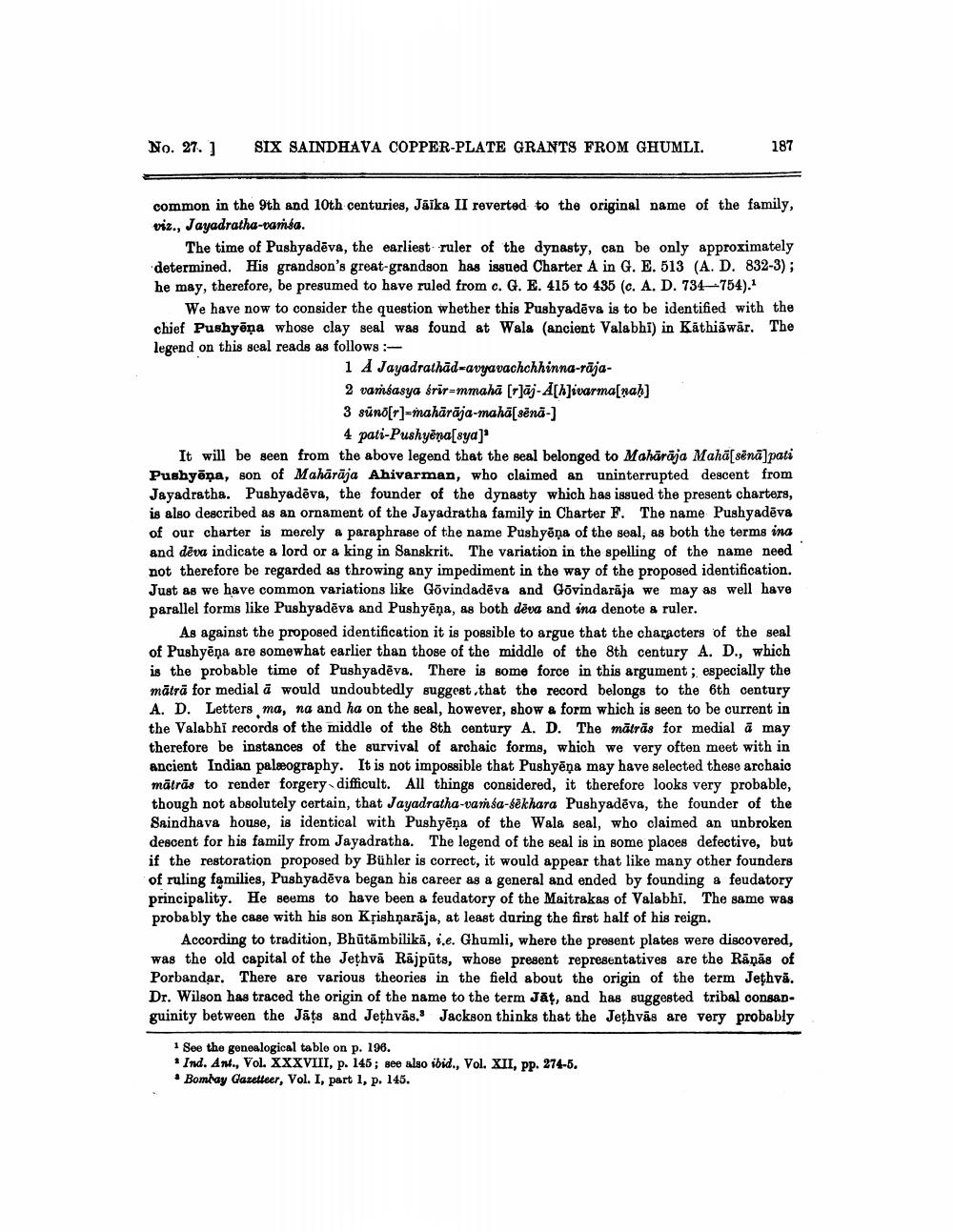________________
No. 27. ]
SIX SAINDHAVA COPPER-PLATE GRANTS FROM GHUMLI.
187
common in the 9th and 10th centuries, Jāika II reverted to the original name of the family, viz., Jayadratha-varsa.
The time of Pushyadēva, the earliest ruler of the dynasty, can be only approximately determined. His grandson's great-grandson has issued Charter A in G. E. 513 (A. D. 832-3); he may, therefore, be presumed to have ruled from c. G. E. 415 to 435 (c. A. D. 734-754).
We have now to consider the question whether this Pushyadēva is to be identified with the chief Pushyāṇa whose clay seal was found at Wala (ancient Valabhi) in Käthiāwār. The legend on this seal reads as follows:
1 Jayadrathād=avyavachchhinna-rāja2 vambasya srir=mmahā (r]āj-A[Alivarma[nah) 3 sūnõ[r]=mahārāja-mahā[sēnā-)
4 pati-Pushyēna[sya)' It will be seen from the above legend that the seal belonged to Mahäräja Mahäs sënā pati Pushyāņa, son of Mahārāja Ahivarman, who claimed an uninterrupted descent from Jayadratha. Pushyadēva, the founder of the dynasty which has issued the present charters, is also described as an ornament of the Jayadratha family in Charter F. The name Pushyadēv& of our charter is merely a paraphrase of the name Push yêņa of the seal, as both the terms ina and dēva indicate a lord or a king in Sanskrit. The variation in the spelling of the name need not therefore be regarded as throwing any impediment in the way of the proposed identification. Just as we have common variations like Govindadēva and Govindarāja we may as well have parallel forms like Pushyadēva and Pushyēņa, as both dēva and ina denote a ruler.
As against the proposed identification it is possible to argue that the characters of the seal of Pushyēna are somewhat earlier than those of the middle of the 8th century A. D., which is the probable time of Pushyadēva. There is some force in this argument; especially the mātrā for medial ā would undoubtedly suggest that the record belongs to the 6th century A. D. Letters ma, na and ha on the seal, however, show & form which is seen to be current in the Valabhi records of the middle of the 8th century A. D. The mātrās for medial à may therefore be instances of the survival of archaic forms, which we very often meet with in ancient Indian palæography. It is not impossible that Pushyēņa may have selected these archaic mātrās to render forgery difficult. All things considered, it therefore looks very probable, though not absolutely certain, that Jayadratha-vaṁsa-sēkhara Pushyadeva, the founder of the Saindhava house, is identical with Pushyēņa of the Wala seal, who claimed an unbroken descent for his family from Jayadratha. The legend of the seal is in some places defective, but if the restoration proposed by Bühler is correct, it would appear that like many other founders of ruling families, Pushyadēva began his career as a general and ended by founding a feudatory principality. He seems to have been a feudatory of the Maitrakas of Valabhi. The same was probably the case with his son Kțishộarāja, at least during the first half of his reign.
According to tradition, Bhūtāmbilikā, i.e. Ghumli, where the present plates were discovered, was the old capital of the Jethvā Rājpūts, whose present representatives are the Rāņās of Porbandar. There are various theories in the field about the origin of the term Jethva. Dr. Wilson has traced the origin of the name to the term Jāt, and has suggested tribal conganguinity between the Jāts and Jethvās. Jackson thinks that the Jethvās are very probably
1 See the genealogical table on p. 196. * Ind. Ant., Vol. XXXVIII, p. 145; see also ibid., Vol. XII, pp. 274-5. • Bomlay Gazetteer, Vol. I, part 1, p. 145.




